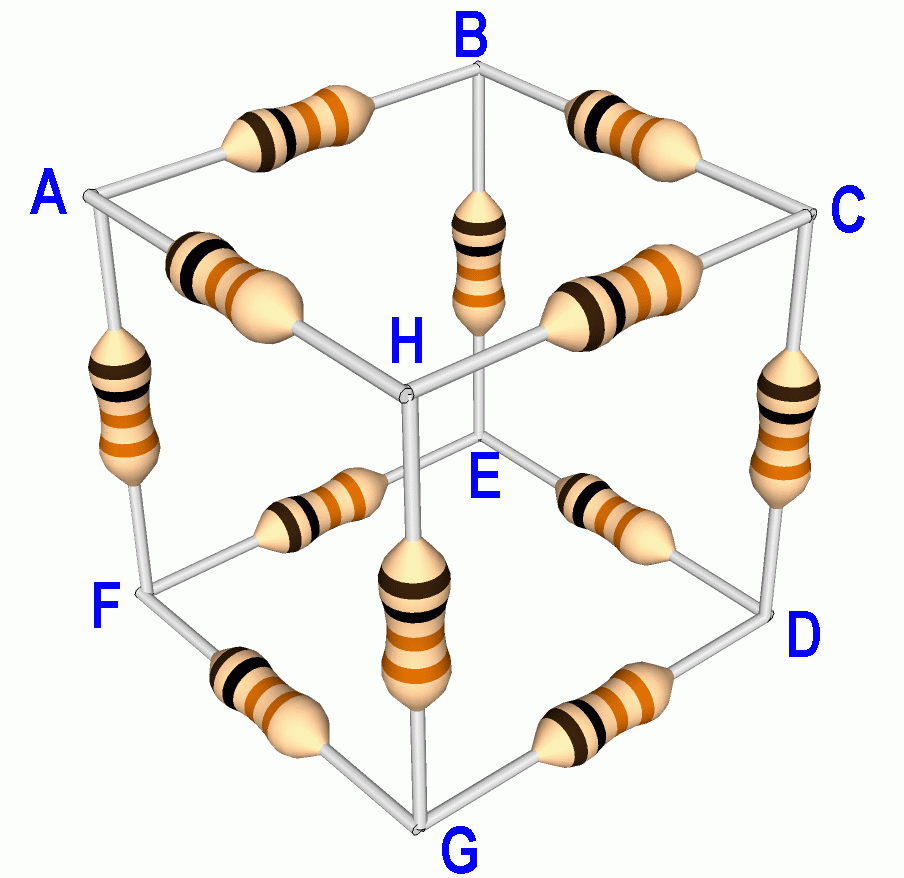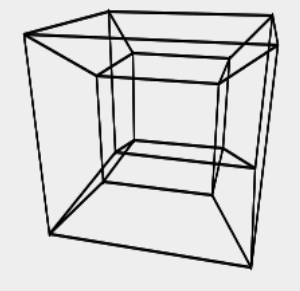The Resistor Tesseract.
 |
| A cube of resistors. |
|---|
The classic resistor cube is an old problem, but still challenging if you haven't seen it. Twelve identical resistors of resistance R are soldered together in a cubic network. What is its resistance when measured with an ohmmeter between opposite corners A and D?
If you want more difficult problems, find the resistance of the cube when measured across just one of its resistors, between points A and B. Or across the opposite corners of one face, between points A and C. Or remove one resistor and insert an ohmmeter where it was. That should keep you amused for a while.
Hint: This network has lots of symmetry. That allows for insightful solutions. There are also difficult solutions. See reference [2] for a solution that uses Wye-Delta transformations. That website is the source of the nice graphic. But you don't need all that. It's like using a sledgehammer to crack a walnut. Look for simpler solutions using Kirchoff's laws.
 |
| One way to project a tesseract onto a flat page. |
|---|
But these were too easy. How about making a hypercube (tesseract) using 32 identical resistors. A tesseract is a four-dimensional cube. What is its resistance measured across opposite corners. Opposite corners are those for which a path betweeen them traverses the greatest number of edges just once.
Feedback is appreciated from readers. Email dsimanek@lhup.edu. If you have a favorite physics puzzle that is not well known, not easily found on the web, or in the many published physics problem books, send it along. Include your answer, if you have one. If your idea is used, we'll credit you. I especially like puzzles that can be solved with insightful and simple arguments, preferably with minimal mathematics.
Answer.
Most any puzzle has a long history. This one appeared in 1914 in a physics textbook. [1] It baffles freshman because it cannot be broken down into series and parallel resistor configurations. They may not have heard of Kirchoff's laws: (1) the net current at any junction is zero, and (2) the potential drops add to zero around any closed loop. These are the key to solving any complex circuit.The corner-to-corner resistance of a cubic network of 12 identical resistors of value R may be solved by adding voltage drops from corner to corner due to current into one corner and out the other. At corner A the current divides equally into three resistors. Then each divides again into two resistors. After that, current from two resistors combines and we have arrived at point B. The sum of the voltage drops is V = IR/3 + IR/6 + IR/3 = 5IR/6. So the resistance of the cube is R = V/I = (5/6)R. For the other answers see reference [4].
When I hatched the notion of the hypercube of resistors I supposed it would be fiendishly complex to solve. Not so. The hypercube form is a red herring, because any n-dimensional wire frame structure can be topologicfally projected into one less dimension, and so on, until it is "flattened" in two dimensions. Projection of that into one dimension is usually unproductive. Of course this doesn't preserve lengths, but that doesn't matter. Only the resistances of the cube edges matters. Granted, when flattening the circuit you'll get lots of wire cross-overs. But that's common in circuit diagrams.
The difficulty of the tesseract version lies in doing the projection of it onto a flat page in a manner that still retains its electrical network connections, and still displays its symmetries. The "opposite" corners are two points with the longest path between them, measured not in lengths, but in number of resistors traversed. That path traverses just four resistors. By symmetry the voltage drop along the first two resistors equals the voltage drop between the last two. Let current I enter the hypercube at corner A. The current then splits into four parts—equal parts because of symmetry. Choose one of them. After passing through one resistor the current splits again into three parts, all equal. Across the first resistor the voltage drop is IR/4. Across the second resistor it is one third of that, or IR/12. The total voltage drop thus far is IR/4 + IR/12. Now remember that, by symmetry, we are halfway to the opposite corner, and over the next two resistors in the path we get this same voltage drop for a total drop from A to B of IR/4 + IR/12 + IR/12 + IR/4 = 8IR/12 = 2R/3. So the resistance from A to B is R = V/I = (2/3)R .
References.
- Brooks, E. E. and A. W. Poyser, Electricity and Magnetism: A Manual for Advanced Classes, Longmans, Green, 1914.
- M. Eric Carr. Wye Knot. The Paleotechnologist.
- Pippenger, Nicholas. The hypercube of resistors. American Mathematical Monthly, 10 Apr. 2009. More than you proably want to know about these problems.
- Simanek, Donald. Challenging Physics Problems with answers.
Return to Physics puzzles.
Return to the Donald Simanek's home page.